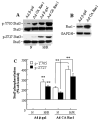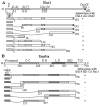Activation of Stat3 in endothelial cells following hypoxia-reoxygenation is mediated by Rac1 and protein Kinase C
- PMID: 22791907
- PMCID: PMC3392026
- DOI: 10.1016/j.bbamcr.2012.02.008
Activation of Stat3 in endothelial cells following hypoxia-reoxygenation is mediated by Rac1 and protein Kinase C
Abstract
Stat3 is an important transcription factor that regulates both proinflammatory and anit-apoptotic pathways in the heart. This study examined the mechanisms of activation of Stat3 in human endothelial cells following hypoxia/reoxygenation (H/R). By expression of constitutively active Rac1 mutant protein, and by RNA silencing of Rac1, we found that Stat3 forms a multiprotein complex with Rac1 and PKC in an H/R-dependent manner, which at least in part, appears to regulate Stat3 S727 phosphorylation. Selective inhibition of PKC with calphostin C produces a marked suppression of Stat3 S727 phosphorylation. The association of Stat3 with Rax1 occurs predominantly at the cell membrane, but also inside the nucleus, and occurs through the binding of the coiled-coil domain of Stat3 to the 54 NH(2)-terminal residues of Rac1. Transfection with a peptide comprising the NH(2)-terminal 17 amino acid residues of Rac1-dependent signaling pathways resulting in physical association between Rac1 and Stat3 and the formation of a novel multiprotein complex with PKC.
Keywords: Stat3; endothelial cells; inflammation; protein kinase C; protein-protein interaction; reactive oxygen species.
Figures









Similar articles
-
Regulation of STAT3 by direct binding to the Rac1 GTPase.Science. 2000 Oct 6;290(5489):144-7. doi: 10.1126/science.290.5489.144. Science. 2000. PMID: 11021801
-
Phospholipase D-mediated activation of IQGAP1 through Rac1 regulates hyperoxia-induced p47phox translocation and reactive oxygen species generation in lung endothelial cells.J Biol Chem. 2009 May 29;284(22):15339-52. doi: 10.1074/jbc.M109.005439. Epub 2009 Apr 14. J Biol Chem. 2009. PMID: 19366706 Free PMC article.
-
Protein Kinase C-ζ stimulates colorectal cancer cell carcinogenesis via PKC-ζ/Rac1/Pak1/β-Catenin signaling cascade.Biochim Biophys Acta Mol Cell Res. 2018 Apr;1865(4):650-664. doi: 10.1016/j.bbamcr.2018.02.002. Epub 2018 Feb 10. Biochim Biophys Acta Mol Cell Res. 2018. PMID: 29408512
-
Signal transducer and activator of transcription 3alpha and specificity protein 1 interact to upregulate intercellular adhesion molecule-1 in ischemic-reperfused myocardium and vascular endothelium.Arterioscler Thromb Vasc Biol. 2005 Jul;25(7):1395-400. doi: 10.1161/01.ATV.0000168428.96177.24. Epub 2005 Apr 28. Arterioscler Thromb Vasc Biol. 2005. PMID: 15860735
-
Src regulates phorbol 12-myristate 13-acetate-activated PKC-induced migration via Cas/Crk/Rac1 signaling pathway in glioblastoma cells.Int J Mol Med. 2007 Oct;20(4):511-9. Int J Mol Med. 2007. PMID: 17786281
Cited by
-
An anti-cancer WxxxE-containing azurin polypeptide inhibits Rac1-dependent STAT3 and ERK/GSK-3β signaling in breast cancer cells.Oncotarget. 2017 Jun 27;8(26):43091-43103. doi: 10.18632/oncotarget.17759. Oncotarget. 2017. PMID: 28549350 Free PMC article.
-
Activated Rac1 regulates the degradation of IκBα and the nuclear translocation of STAT3-NFκB complexes in starved cancer cells.Exp Mol Med. 2016 May 6;48(5):e231. doi: 10.1038/emm.2016.17. Exp Mol Med. 2016. PMID: 27151455 Free PMC article.
-
Standardized Pre-clinical Surgical Animal Model Protocol to Investigate the Cellular and Molecular Mechanisms of Ischemic Flap Healing.Biol Proced Online. 2024 Jan 17;26(1):2. doi: 10.1186/s12575-023-00227-w. Biol Proced Online. 2024. PMID: 38229030 Free PMC article.
-
LncRNA-encoded polypeptide ASRPS inhibits triple-negative breast cancer angiogenesis.J Exp Med. 2020 Mar 2;217(3):jem.20190950. doi: 10.1084/jem.20190950. J Exp Med. 2020. PMID: 31816634 Free PMC article.
-
JAK2/STAT3 inhibition attenuates noise-induced hearing loss.PLoS One. 2014 Oct 2;9(9):e108276. doi: 10.1371/journal.pone.0108276. eCollection 2014. PLoS One. 2014. PMID: 25275304 Free PMC article.
References
-
- Das DK. Redox regulation of cardiomyocyte survival and death. Antioxid Redox Signal. 2001;3:23–37. - PubMed
-
- Valen G. Signal transduction through nuclear factor kappa B in ischemia-reperfusion and heart failure. Basic Res Cardiol. 2004;99:1–7. - PubMed
-
- Soond SM, Latchman DS, Stephanou A. STAT signalling in the heart and cardioprotection. Expert Rev Mol Med. 2006;8:1–16. - PubMed
-
- Yang XP, Irani K, Mattagajasingh S, Dipaula A, Khanday F, Ozaki M, Fox-Talbot K, Baldwin WM, 3rd, Becker LC. Signal transducer and activator of transcription 3alpha and specificity protein 1 interact to upregulate intercellular adhesion molecule-1 in ischemic-reperfused myocardium and vascular endothelium. Arterioscler Thromb Vasc Biol. 2005;25:1395–400. - PubMed
Publication types
MeSH terms
Substances
Grants and funding
LinkOut - more resources
Full Text Sources
Molecular Biology Databases
Research Materials
Miscellaneous

